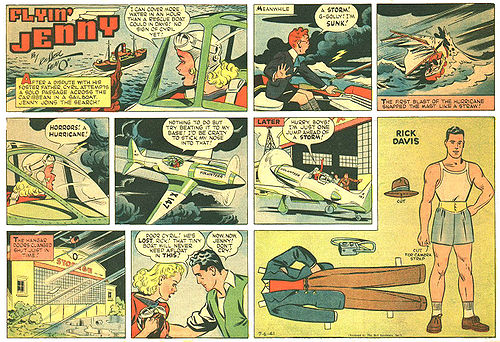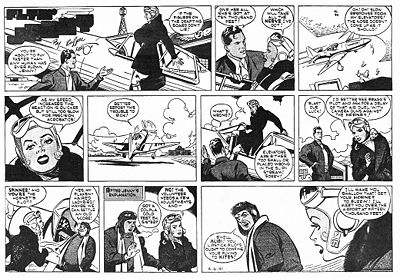
Flyin' Jenny
Encyclopedia

Comic strip
A comic strip is a sequence of drawings arranged in interrelated panels to display brief humor or form a narrative, often serialized, with text in balloons and captions....
created by illustrator Russell Keaton and distributed to newspapers by Bell Syndicate. Launched in October 1939, Flyin' Jenny was published both as a daily
Daily strip
A daily strip is a newspaper comic strip format, appearing on weekdays, Monday through Saturday, as contrasted with a Sunday strip, which typically only appears on Sundays....
and Sunday strip
Sunday strip
A Sunday strip is a newspaper comic strip format, where comic strips are printed in the Sunday newspaper, usually in a special section called the Sunday comics, and virtually always in color. Some readers called these sections the Sunday funnies...
, each running a separate storyline.
Characters and story
Initially a test pilot at the Starcraft Aviation Factory, Jenny encountered spies, saboteurs and criminals. Since the strip began simultaneously with the start of World War IIWorld War II
World War II, or the Second World War , was a global conflict lasting from 1939 to 1945, involving most of the world's nations—including all of the great powers—eventually forming two opposing military alliances: the Allies and the Axis...
, Jenny was active in wartime escapades.
Keaton's widow, Virginia Keaton Anderson, recalled how he devised the name of the central character. He originally planned to name the strip's heroine Virginia Dare. Delighted that he wanted to use her name, Virginia Keaton cautioned, "Russell, I'm not criticizing, but historians might. Remember, Virginia Dare
Virginia Dare
Virginia Dare was the first child born in the Americas to English parents, Eleanor and Ananias Dare. She was born into the short-lived Roanoke Colony in what is now North Carolina, USA. What became of Virginia and the other colonists remains a mystery...
was the name of the first child born of English parents in this country. Why don't you name her Virginia something else?" Keaton explained that he had specific reasons for choosing his character's last name as well as the first: "No, I want to name her Dare because I'm going to make her a daring young aviatrix." Then he had an idea: "Jenny is a nickname for Virginia. I'll name her Jenny Dare."
The Curtiss JN-4
Curtiss JN-4
The Curtiss JN-4 "Jenny" was one of a series of "JN" biplanes built by the Curtiss Aeroplane Company of Hammondsport, New York, later the Curtiss Aeroplane and Motor Company. Although the Curtiss JN series was originally produced as a training aircraft for the U.S...
, known as "Jenny," was made by Curtiss in 1915, and it was filmed by Lee De Forest
Lee De Forest
Lee De Forest was an American inventor with over 180 patents to his credit. De Forest invented the Audion, a vacuum tube that takes relatively weak electrical signals and amplifies them. De Forest is one of the fathers of the "electronic age", as the Audion helped to usher in the widespread use...
in Flying Jenny Airplane (1921), a short film with the sound of the aircraft.

Gladys Parker
Gladys Parker was an American cartoonist for comic strips and a fashion designer in Hollywood. She is best known as the creator of the comic strip Mopsy which had a long run over three decades....
stepped in to draw Flyin' Jenny from 1942 until 1944 when Keaton's assistant Marc Swayze
Marc Swayze
Marc Swayze was an American comic book artist from 1941-53 for Fawcett Publications.He is best known for his work on Captain Marvel and the Marvel Family during the Golden Age of comic books for Fawcett Comics, and is the co-creator of Mary Marvel with writer Otto Binder...
took over.
After Keaton died in 1945 (at the age of 35), Swayze and scripter Glenn Chaffin made an effort to keep Jenny airborne, but it became difficult to devise adventures equal to those of the WWII years. The strip began to lose its popularity and was discontinued in 1946.

